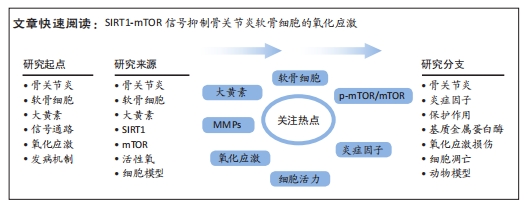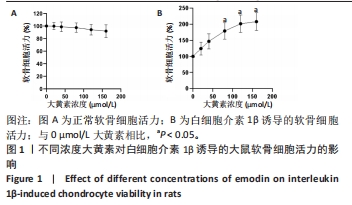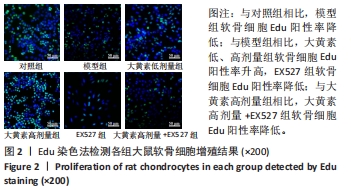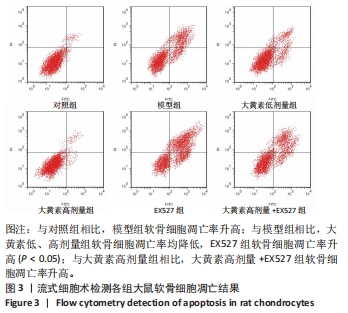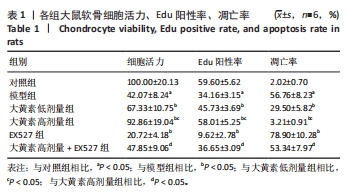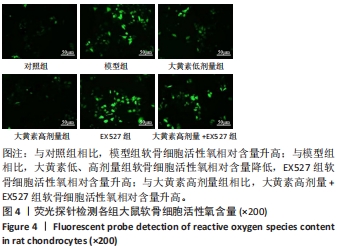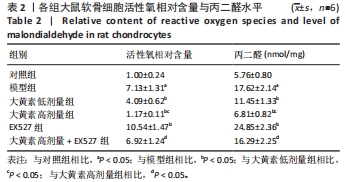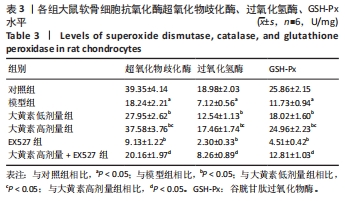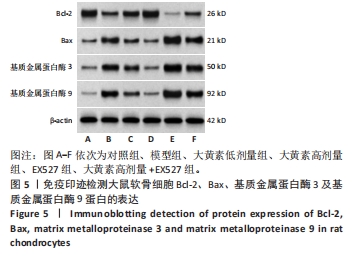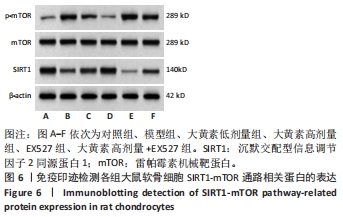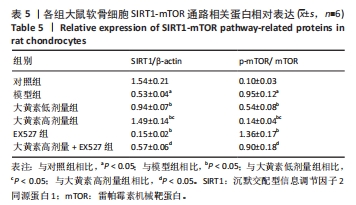[1] QUICKE JG, CONAGHAN PG, CORP N, et al. Osteoarthritis year in review 2021: epidemiology & therapy. Osteoarthritis Cartilage. 2022; 30(2):196-206.
[2] JIANG Y. Osteoarthritis year in review 2021: biology. Osteoarthritis Cartilage. 2022;30(2):207-215.
[3] MINGUZZI M, CETRULLO S, D’ADAMO S, et al. Emerging players at the intersection of chondrocyte loss of maturational arrest, oxidative stress, senescence and low-grade inflammation in osteoarthritis. Oxid Med Cell Longev. 2018;2018:3075293.
[4] BLANCO FJ, REGO I, RUIZ-ROMERO C. The role of mitochondria in osteoarthritis. Nat Rev Rheumatol. 2011;7(3):161-169.
[5] HOSSEINZADEH A, KAMRAVA SK, JOGHATAEI MT, et al. Apoptosis signaling pathways in osteoarthritis and possible protective role of melatonin. J Pineal Res. 2016;61(4):411-425.
[6] BLANCO FJ, VALDES AM, REGO-PÉREZ I. Mitochondrial DNA variation and the pathogenesis of osteoarthritis phenotypes. Nat Rev Rheumatol. 2018;14(6):327-340.
[7] WAN C, LIU W, JIANG L, et al. Knockdown of MKL1 ameliorates oxidative stress-induced chondrocyte apoptosis and cartilage matrix degeneration by activating TWIST1-mediated PI3K/AKT signaling pathway in rats. Autoimmunity. 2022;55(8):559-566.
[8] KANG D, LEE J, JUNG J, et al. Selenophosphate synthetase 1 deficiency exacerbates osteoarthritis by dysregulating redox homeostasis. Nat Commun. 2022;13(1):779-792.
[9] LIU L, ZHANG W, LIU T, et al. The physiological metabolite α-ketoglutarate ameliorates osteoarthritis by regulating mitophagy and oxidative stress. Redox Biol. 2023;62:102663.
[10] LU Y, ZHOU L, WANG L, et al. The role of SIRT1 in BMP2-induced chondrogenic differentiation and cartilage maintenance under oxidative stress. Aging (Albany NY). 2020;12(10):9000-9013.
[11] MA T, LV L, YU Y, et al. Bilobalide exerts anti-inflammatory effects on chondrocytes through the AMPK/SIRT1/mTOR pathway to attenuate ACLT-induced post-traumatic osteoarthritis in rats. Front Pharmacol. 2022;13:783506.
[12] LU H, JIA C, WU D, et al. Fibroblast growth factor 21 (FGF21) alleviates senescence, apoptosis, and extracellular matrix degradation in osteoarthritis via the SIRT1-mTOR signaling pathway. Cell Death Dis. 2021;12(10):865-877.
[13] 张小红, 王红民, 李杨, 等. 大黄素对肺炎链球菌肺炎大鼠氧化应激损伤及miR-34a/SIRT1轴的影响[J]. 天津医药,2021,49(6):588-592.
[14] LIU Z, LANG Y, LI L, et al. Effect of emodin on chondrocyte viability in an in vitro model of osteoarthritis. Exp Ther Med. 2018;16(6):5384-5389.
[15] 顾晓东. 组蛋白去乙酰化酶4通过抑制内质网应激介导的软骨细胞凋亡延缓骨关节炎关节软骨退变的研究[D]. 太原:山西医科大学,2020.
[16] 顾晓东, 李鹏翠, 李飞. 组蛋白去乙酰化酶4在大鼠骨关节炎软骨退变中的变化趋势及作用[J]. 中国骨质疏松杂志,2022,28(11): 1588-1592+1639.
[17] 杨桂梅, 孙玉梅, 颜淑云, 等. 大黄素对内毒素诱导的牙龈成纤维细胞ROS/MAPK/AP-1通路及炎性因子表达的影响[J]. 实用口腔医学杂志,2022,38(3):359-363.
[18] 王新立, 刘汝银, 王西彬, 等. 牛膝总皂苷对大鼠椎间盘髓核细胞外基质合成的影响[J]. 中成药,2020,42(1):69-74.
[19] ZHUANG H, REN X, JIANG F, et al. Indole-3-propionic acid alleviates chondrocytes inflammation and osteoarthritis via the AhR/NF-κB axis. Mol Med. 2023;29(1):17.
[20] CAI W, ZHANG Y, JIN W, et al. Procyanidin B2 ameliorates the progression of osteoarthritis: An in vitro and in vivo study. Int Immunopharmacol. 2022;113(Pt A):109336.
[21] LI Z, HUANG Z, ZHANG H, et al. P2X7 receptor induces pyroptotic inflammation and cartilage degradation in osteoarthritis via NF-κB/NLRP3 crosstalk. Oxid Med Cell Longev. 2021;2021:8868361.
[22] YAO J, LONG H, ZHAO J, et al. Nifedipine inhibits oxidative stress and ameliorates osteoarthritis by activating the nuclear factor erythroid-2-related factor 2 pathway. Life Sci. 2020;253:117292.
[23] LU H, JIA C, WU D, et al. Fibroblast growth factor 21 (FGF21) alleviates senescence, apoptosis, and extracellular matrix degradation in osteoarthritis via the SIRT1-mTOR signaling pathway. Cell Death Dis. 2021;12(10):865.
[24] COLLETTI A, CICERO AFG. Nutraceutical approach to chronic osteoarthritis: from molecular research to clinical evidence. Int J Mol Sci. 2021;22(23):12920.
[25] WHITTAKER JL, RUNHAAR J, BIERMA-ZEINSTRA S, et al. A lifespan approach to osteoarthritis prevention. Osteoarthritis Cartilage. 2021; 29(12):1638-1653.
[26] MARIANO A, BIGIONI I, MISITI F, et al. The nutraceuticals as modern key to achieve erythrocyte oxidative stress fighting in osteoarthritis. Curr Issues Mol Biol. 2022;44(8):3481-3495.
[27] CHEN Z, ZHAO C, LIU P, et al. Anti-apoptosis and autophagy effects of melatonin protect rat chondrocytes against oxidative stress via regulation of AMPK/Foxo3 pathways.Cartilage.2021;13(2_suppl): 1041S-1053S.
[28] 李浩亮, 李东方. 大黄素抑制miR-338-3p表达促进骨质疏松性骨折大鼠的愈合[J]. 中国组织工程研究,2022,26(32):5155-5161.
[29] 兰伟斌, 阙武堂, 谢建鸿, 等. 大黄素通过抑制NF-κB信号通路改善骨关节炎的软骨降解分析[J]. 中国免疫学杂志,2023,39(2):308-312.
[30] CHEN M, HUANG L, LV Y, et al. Sulforaphane protects against oxidative stress‑induced apoptosis via activating SIRT1 in mouse osteoarthritis. Mol Med Rep. 2021; 24(2):612.
[31] MEI R, LOU P, YOU G, et al. 17β-estradiol induces mitophagy upregulation to protect chondrocytes via the SIRT1-mediated AMPK/mTOR signaling pathway. Front Endocrinol (Lausanne). 2021; 11:615250.
[32] WANG C, YAO Z, ZHANG Y, et al. Metformin mitigates cartilage degradation by activating AMPK/SIRT1-mediated autophagy in a mouse osteoarthritis model. Front Pharmacol. 2020;11:1114. |
